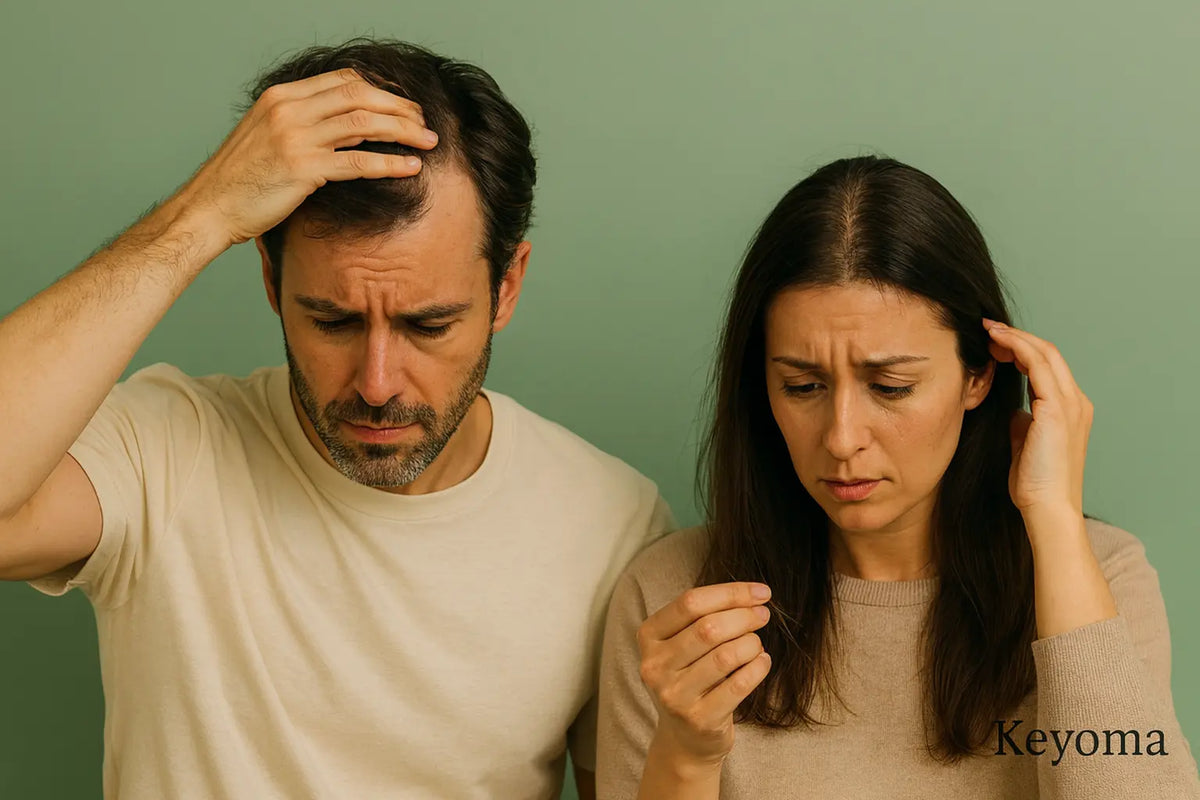In this article
Hair loss can feel personal, almost like it’s stealing a part of your identity. And it doesn’t help when you catch yourself in the mirror and see your hairline creeping back or notice your ponytail isn’t as full as it once was.
But there’s no need to stay discouraged or quietly envious of that friend with thick, effortless hair—because here’s the truth: hair loss can be reversed. The catch? It usually happens only if you spot the signs early and tackle the root cause with proven methods.
In this guide, we’ll explore what’s possible when it comes to reversing hair loss, what’s not, and the methods that can make a real difference.
Key Takeaways
-
Hair loss reversibility depends entirely on the cause.
-
Acting early with the right treatment greatly improves your chances of regrowth.
-
The most effective approach addresses the root cause while keeping the scalp clean, balanced, and healthy
Reversible Types of Hair Loss
Hair loss from short-term changes in the growth cycle or scalp health can often be reversed.
Telogen Effluvium
Telogen effluvium happens when something, be it a tough bout of stress or a serious illness, pushes more hair follicles than usual into their resting (telogen) phase all at once. As a result, more strands shed than grow, and the change can be quite noticeable.
Common triggers include major surgery, childbirth, strict crash diets, or infections that "shock" the body and throw it off balance.
The encouraging part? This type of hair loss can be reversed once the root cause is identified and addressed, and your hair usually begins to grow back within three to six months.
We’ll cover what you can do later, but it often involves improving your diet, correcting nutritional deficiencies, or managing stress with intention.
Postpartum Shedding
Postpartum shedding is a natural response to the hormonal changes after childbirth, especially the sharp drop in estrogen. These same hormonal shifts are also connected to telogen effluvium, as mentioned earlier, but can also happen naturally during puberty or menopause.
If you're one of the many women in the same boat, you'll start to notice more hair on your pillow or in the shower about two to six months after giving birth, which can feel alarming, even dramatic.
The good news is that the follicles stay healthy. Most women see their hair return to its pre-pregnancy fullness within six to twelve months. In the meantime, gentle hair care, balanced nutrition, and a little self-compassion go a long way toward helping you through the transition.
Early-Stage Traction Alopecia
If you’re fond of everyday braids, ponytails, extensions, or even certain chemical treatments, know that you're putting constant stress on your hair follicles. This constant pulling can lead to early-stage traction alopecia, which often first shows up along the hairline or where the tension is strongest.
Reversing the thinning is possible by switching to looser hairstyles or alternating styles every few days to give your follicles a break and allow them to recover. Pair this with some scalp TLC and a consistent hair oiling routine and you can expect those baby hairs start to return.
Thyroid-Related Hair Loss
Both an underactive (hypothyroidism) and overactive (hyperthyroidism) thyroid can throw off the hair growth cycle and bring more hairs to enter the resting phase prematurely.
This leads to widespread thinning across the scalp, alongside other symptoms like fatigue, changes in weight, or unusual sensitivity to heat or cold.
In this case, the first step toward reversing hair loss is to confirm the diagnosis, usually with blood tests ordered by a healthcare professional.
Once the underlying thyroid imbalance is identified and treated, whether through medication, dietary support, or other medical interventions, your hair often begins regrowing within a few months of restoring hormonal balance.
Iron/Vitamin Deficiency Hair Loss
When the body runs low on key nutrients like iron, vitamin D, or B12, hair can lose its strength and growth can slow. In fact, iron deficiency anemia is one of the most common culprits, especially in women who menstruate, and research has linked low ferritin levels to increased shedding.
The best way to confirm a deficiency is through lab testing. Once the results are in, addressing your hair loss often points to dietary changes and supplementation, ideally under your doctor’s guidance.
Seborrheic Dermatitis-Related Shedding
Seborrheic dermatitis is a common scalp condition marked by flaking, redness, and itching. It often happens when Malassezia yeast grows too much on the scalp, and the resulting inflammation can cause temporary shedding and make dandruff more noticeable.
Scalp hygiene is the main focus here to help reduce inflammation. Treatment options usually involve medicated shampoos with ingredients like ketoconazole, zinc pyrithione, or selenium sulfide. Once the inflammation eases, hair growth often resumes.
Medication-Induced Hair Loss
Some medications, such as chemotherapy drugs, blood thinners, beta‑blockers, and certain antidepressants, can trigger temporary hair shedding by interrupting the normal growth cycle.
If you think a prescription might be the cause, talk to your healthcare provider about possible alternatives or dosage changes. In many cases, once the medication is stopped or replaced, hair begins to regrow within a few months.
Irreversible Types of Hair Loss
Androgenetic Alopecia
Androgenetic alopecia, commonly called male or female pattern baldness, is a hereditary condition that causes gradual thinning over time.
In its advanced stages, this hereditary thinning, primarily caused by years of exposure to dihydrotestosterone (DHT), shrinks the follicles so much that they can no longer produce visible hair—permanently.
At that point, many people turn to cosmetic procedures or surgeries, such as hair transplants.
Scarring (Cicatricial) Alopecias
Cicatricial alopecias are a group of uncommon disorders in which inflammation destroys hair follicles and replaces them with scar tissue. Once this scarring occurs, hair loss is virtually irreversible.
Causes can range from autoimmune diseases like lichen planopilaris to certain infections or physical injury to the scalp.
Late-Stage Traction Alopecia
If you have an aunt who swore by her tight braids and chemical relaxers, until one day she told you, “Don’t ever do what I did”—she’s really telling you she’s a victim of late-stage traction alopecia. In these cases, the follicles are replaced by scar tissue, so natural regrowth can no longer happen.
The best way to prevent this is to switch to looser styles early, before permanent damage sets in.
Tips to Help Reverse Hair Loss
Use Topical Nature Oils
To be clear, evidence that botanical oils can directly regrow hair is limited. But their nourishing, moisturizing, and cleansing properties can help create a healthier scalp environment—one that supports regrowth and reduces breakage, especially in the early stages of thinning.
Batana oil, for example, has a long history as a traditional remedy for baldness, with its cultural use now finding a place in mainstream hair care. Coconut oil and castor oil are also widely used and valued in their own right for their scalp-nourishing benefits.
Eat a Balanced Meal Daily
Your follicles need a steady supply of protein, essential fatty acids, vitamins A, C, D, and E, plus minerals like iron and zinc, to keep it from weakening and becoming brittle.
So, build your plate with nutrient‑rich foods. Eggs, leafy greens, nuts, seeds, and oily fish. If blood tests reveal a deficiency, your doctor may recommend targeted supplements to restore those nutrients.
Keep Your Scalp Clean
Good scalp hygiene helps prevent issues like itching, redness, flaking, or excess oil that can contribute to shedding.
Wash regularly with a gentle shampoo that removes product buildup and choose formulas with mild antifungal agents or prebiotics to support a healthy scalp microbiome.
If your scalp feels irritated, soothing options like aloe vera gel or chamomile rinses can calm inflammation and keep the environment comfortable for healthy growth.
Avoid Heat, Chemicals & Tight Styles
When it comes down to it, it's all about easing the mechanical and chemical strain that can make thinning worse over time. Small, everyday habits you can start now that lead to big, long‑term improvements include:
-
Let hair air‑dry instead of using high heat
-
Apply a heat protectant before any styling with hot tools
-
Rotate tight hairstyles with looser ones, or wear them every other day instead of daily
-
Avoid harsh chemical treatments like bleach, strong relaxers, or frequent coloring
Use Proven Hair Growth Boosters
Some treatments are backed by strong evidence, while others show promise in early studies. Minoxidil, as mentioned earlier, is a clinically proven option that can stimulate follicles and extend the growth phase.
If you're looking for more plant-based or non-synthetic options, go for rosemary oil, caffeine serums, and peptide formulations. These aren't as well-studied as minoxidil, but they may still support a healthy growth cycle when used consistently.
Lower Stress & Sleep Better for Stronger Hair
Chronic stress raises cortisol levels—and that’s bad news for your hair. High cortisol can disrupt the growth cycle and lead to more shedding. Some simple stress‑relief practices you can do include:
-
Getting seven to nine hours of good‑quality sleep each night
-
Practicing meditation, deep breathing, or yoga
-
Drinking enough water throughout the day to stay hydrated
Frequently Asked Questions (FAQs)
Is hair loss permanent?
Whether hair loss is permanent depends on the condition of your follicles. If they’re still alive and functional, there’s a chance for regrowth. But when scarring has destroyed them, the loss can be irreversible.
Which types of hair loss are reversible vs permanent?
Some causes are temporary, such as telogen effluvium, nutritional deficiencies, postpartum shedding, and early-stage traction alopecia. Others, like scarring alopecias and late-stage androgenetic alopecia are typically permanent.
Is hair loss reversible in females?
Many women experience hair loss that can be reversed, such as postpartum shedding, hormone-related changes, or shedding from nutritional deficiencies. Female pattern hair loss, on the other hand, is usually manageable but not fully reversible, particularly in its later stages.
Is hair loss reversible in men?
For men, the most common cause is androgenetic alopecia, which is progressive but can often be slowed or improved if treated early. Temporary types, such as those triggered by illness, stress, or deficiencies, are just as reversible in men as they are in women.
Can hair fall be fully reversed?
Full reversal is possible only if the hair follicles are still alive and undamaged. In those cases, regrowth can happen, though it may be partial. Results vary from person to person, and keeping those gains usually requires ongoing care so the progress isn’t lost.
Reversing Hair Loss Starts With Prevention
The sooner you figure out what’s behind the thousands of strands on your pillow or clumps gathering in the shower drain, the more options you’ll have to get those strands growing again.
But rather than waiting for those red flags to show up, the wisest move is always prevention—keeping what you have as strong as possible right from the start.
That’s where habits like regular scalp care and using nourishing hair oils come in. And speaking of hair oils, the Keyoma blog is full of tips, comparisons, and real-world advice on how to choose and use them. Check it out!
Featured Product
100% Pure Batana Oil + Rosemary









